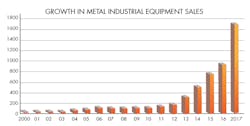Metal AM: Metal Additive Manufacturing Hits Critical Mass
Download this article as a .PDF
Rapid prototyping technology, building parts by creating a series of successive layers, began in the 1980s in Japan and immediately became a subject of interest in the U.S. The first patent, which coined the term stereo lithography (SLA), was granted in 1986 to Chuck Hull in the U.S. His 3D Systems company created the first prototype equipment in 1987 and launched the first commercial equipment in 1988.
Metal AM Beginnings: By the early 1990s, a half-dozen technologies based on layering principles were in the early stages of commercialization. Many subsequent approaches evolved from using liquids as the base material to using powders. Until the advent of powders, it was technically impossible to consider metal prototypes. The race to achieve metal prototypes now began. Twenty-five years later, the industry has achieved metal additive prototypes and is on the cusp of widespread Metal Additive Manufacturing (Metal AM).
Metal AM Status: The American Society of Mechanical Engineers (ASME) held a Leadership Forum in Boston, earlier this month. They assembled a who's who of industry experts from Boeing, GE, Stryker, UPS, the U.S. Marine Corps, and industry leading AM equipment manufacturers to exclusively focus on the state of Metal AM. The forum was moderated by Terry Wohlers of Wohlers Assoc. For 20 years, The Wohlers Report has been the go-to global reference on the progress of rapid prototyping and additive manufacturing. ASME invited me to attend. Here’s a report of my experience at this ASME forum.
Metal AM Growth: Growth in Metal AM sales went geometric from 2013 to 2014. Per the 2018 Wohlers Report, growth is now approaching exponential. There has been an 875% growth in the past five years, and a 220% growth in the past two years alone (Chart below). There are now 135 companies around the globe producing "industrial AM systems," defined as costing more than $5,000, up from 97 in 2016.
Source: Wohlers Assoc., Inc., 2018 Wohlers Report.
Metal AM Leaders: Boeing reported that they have 20 sites producing metal parts and that there are over 60,000 AM parts currently in their deployed aircraft. GE reported that they have over 1,200 employees operating 1,300 machines resulting in over 50,000 parts in the field today. Over 1,000 ongoing Metal AM projects are directed at what GE believes is a $76-billion market opportunity in the next eight years. Stryker just finished building a state-of-the-art facility to address growing opportunities in the med tech industry; and already has over 100,000 Metal AM implants in patients. UPS is planning that Metal AM will be the "4th modality of logistics." Digital libraries will replace the movement of many goods shipped today and UPS plans to be in the middle of it all. UPS is now three years into creating its "Digital Logistics Network" to facilitate on-demand manufacturing. The U.S. Marine Corps is using Metal AM to recreate many parts where spares can no longer be found and the OEMs are out of business. These examples barely do justice to the collective momentum conveyed during ASME's symposium. Again, the recent growth in industrial equipment per the 2018 Wohlers Report marks the industry turning point.
Metal AM Horizons: Appropriately, all participants agreed that Metal AM is not a universal solution. There are many examples where it cannot yet be cost justified. But the capabilities are sufficiently mature to replace traditional manufacturing methods for many parts across many industries.
Metal AM Deterrents: With AM’s manufacturing capability proven, a host of impediments are becoming the new focus. Vibrations in buildings affect the integrity of layers. Materials consistency and environmental homogeneity affect repeatability and quality. Inspection of AM parts that used to be multi-part assemblies requires different skills and calibration techniques. Many regulations and cultural impediments to change impede many opportunities to switch to Metal AM production. And, of course, intellectual property is front and center. Who owns the digital model of an obsolete part that has now been reproduced with Metal AM? Success always begets new challenges. Metal AM is here and on the path to maturation.
About the Author
Bradford Goldense
Contributing Technical Expert
Bradford L. Goldense is founder and president of Goldense Group, Inc. [GGI] (www.goldensegroupinc.com), a consulting, market research, and education firm focused on business and technology management strategies and practices for product creation, development, and commercialization. He has been an adjunct faculty member of the graduate engineering school at Tufts University's Gordon Institute for 19 years. Goldense is a Certified New Product Development Professional [NPDP], a Certified Manufacturing Engineer [CMfgE], a Certified Computer Professional [CCP], and is Certified In Production & Inventory Management [CPIM]. He holds over 200 registered copyrights and is a recognized subject-matter expert, including appearances on PBS and CNBC. He has consulted to over 250 companies and over 750 manufacturing locations on four continents since founding GGI in 1986. Goldense holds an MBA in Accounting from the Cornell Johnson School and a BSCE from Brown University. For more information, please see Brad's LinkedIn profile or visit GGI's home page.


